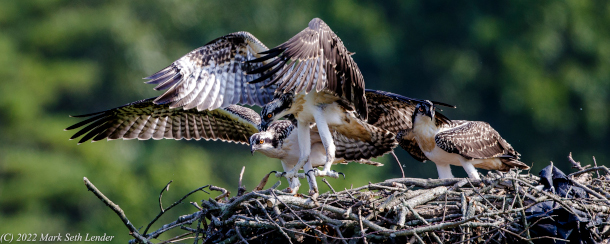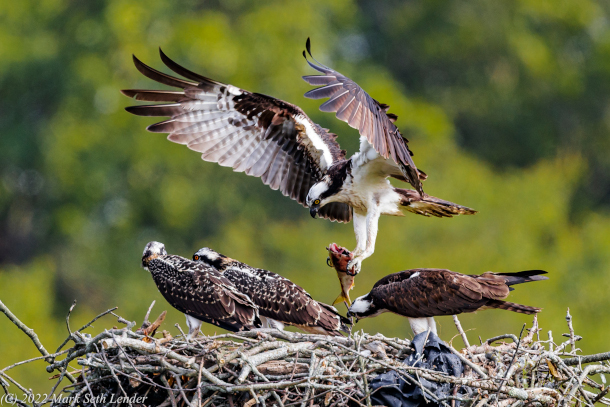“To Fly, To Live:” Osprey of Long Island Sound
Air Date: Week of January 28, 2022

A young osprey chick raises its narrow wings in anticipation of its first flight out of the nest. (Photo: © Mark Seth Lender)
Experience the first flight of young ospreys, a species of hawk known for their elegant dive as they snatch fish from the surface of water. Living on Earth’s Explorer-in-Residence Mark Seth Lender narrates the awkward stretch of their wings and their first, sublime leap outwards.
Transcript
CURWOOD: Not all siblings are born equal. Living on Earth’s Explorer in Residence Mark Seth Lender watched his local osprey nest.
Osprey of Long Island Sound
To Fly To Live
Hammock River Saltmarsh
© 2021 Mark Seth Lender
All Rights Reserved
Three young osprey move about. They are tired of the nest. Its narrow world. Their portion of confinement these long months. It has not rained and it will not rain. Only the saturated heat of August pours down, full force, even at this early hour. The sun clears the tree line. Discomfort grows. Perhaps that is the ultimate stimulus.
It is a rustic show. Flapping and slapping, ungainly. They side-slip and bounce and stumble, hardly an act of grace. When more than anything Grace is what they need. And then by accident and for an instant only -
Up!
And so it begins.
Gravity in surcease.
The Surly Bonds release.
And in the instant every No is Now!
Yes! Yes! What Wings can do.
They are a crowd before the main event, the performance late -
And One and Two and…
Two and Three and …
The sisters are stronger. Their wings broader. Their heights are higher. Their leaping is longer. Born before their brother, female and by nature of greater heft and girth, they have matured. He has not. Those few days? Such an advantage in that small head start.
And One and…
Two and…
Gone!

The father returns to the nest gripping a menhaden’s tail. Unable to wait, one of the chicks opens its beak to take a bite. (Photo: © Mark Seth Lender)
The sisters head off in opposite directions, their brother left behind. His thin chest. His scrawny legs. Inadequate in every way. The harder and faster he flaps the more he founders. He cannot get the hang of it and the effort tires him and only makes him more, incapable. The sisters return. He continues. They watch him in his futility.
Mid-afternoon, their father lands in the nest, a menhaden in his talons. The brother sits sunken into his shoulders. His mother looks at him. With her beak she tears a small piece from the fish. Turning her head sideways to make it easy for him, she puts it into his mouth. Then another.... Bit by bit. Feeding him, like a baby. The sisters stand aside. All of them, his mother, father, the two sisters, all of them want for him what they want for themselves.
To Fly. To Live.
CURWOOD: That’s Living on Earth’s Explorer in Residence Mark Seth Lender.
Links
Read Mark's corresponding field note for this essay
Living on Earth wants to hear from you!
Living on Earth
62 Calef Highway, Suite 212
Lee, NH 03861
Telephone: 617-287-4121
E-mail: comments@loe.org
Newsletter [Click here]
Donate to Living on Earth!
Living on Earth is an independent media program and relies entirely on contributions from listeners and institutions supporting public service. Please donate now to preserve an independent environmental voice.
NewsletterLiving on Earth offers a weekly delivery of the show's rundown to your mailbox. Sign up for our newsletter today!
 Sailors For The Sea: Be the change you want to sea.
Sailors For The Sea: Be the change you want to sea.
 The Grantham Foundation for the Protection of the Environment: Committed to protecting and improving the health of the global environment.
The Grantham Foundation for the Protection of the Environment: Committed to protecting and improving the health of the global environment.
 Contribute to Living on Earth and receive, as our gift to you, an archival print of one of Mark Seth Lender's extraordinary wildlife photographs. Follow the link to see Mark's current collection of photographs.
Contribute to Living on Earth and receive, as our gift to you, an archival print of one of Mark Seth Lender's extraordinary wildlife photographs. Follow the link to see Mark's current collection of photographs.
 Buy a signed copy of Mark Seth Lender's book Smeagull the Seagull & support Living on Earth
Buy a signed copy of Mark Seth Lender's book Smeagull the Seagull & support Living on Earth

